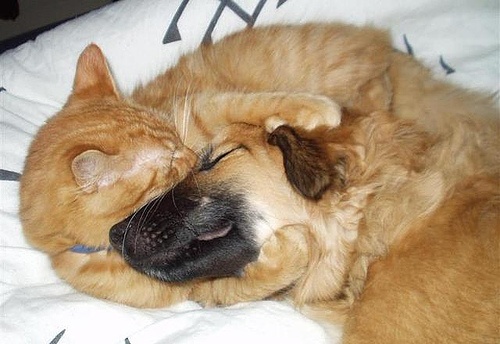Blog
Cats Are Not Small Dogs
July 18, 2013
Cats have critical differences from dogs, anatomically, genetically, and metabolically. Some of the diseases that we treat in cats, such as obesity, diabetes, bladder and kidney problems, and intestinal inflammation, stem from feeding and treating cats as if they were dogs. Understanding these differences helps us nurture and treat our feline companions more successfully.
Originally, thousands of years ago, both species were carnivorous. Dog worked closely with people, guarding their families, herding livestock, and helping hunt for game. Canine temperament, anatomy, and dietary needs changed to jive with the human lifestyle, and dogs thereby became domestic omnivores. Until recent decades cats weren’t really pets; they controlled vermin surrounding the humans, but weren’t fed by them and didn’t become domesticated. Cats have about half the chromosomes dogs do, not because they are inferior, but because cats fit their environmental niche perfectly as predators, so had little genetic pressure to change.

Owned Cat-dog
Both species have very different but highly specialized anatomies. Some examples follow but are by no means complete, the list goes on and on!
- Dogs have 42 teeth made for crushing plant material, whereas cats have 30 teeth made for grasping, tearing, and slicing meat.
- Cats require far more protein than dogs. The cat, unlike omnivores such as the dog, “burns” protein to make energy. They have to use protein, and if it’s limited, they are forced to “burn” through their own constituent proteins (enzymes, antibodies, organ tissues, etc.) to keep their cells alive. Not only do they need lots of protein, but require certain nutrients, such as arachidonic acid and preformed vitamin A, found only in meat. Cats are much more likely to suffer from protein starvation than are dogs when meat is limited. In contrast, dogs burn protein for energy only when there’s a lot of protein (meat or plant-based) in their diet.
- Dogs’ intestinal tracts are longer and more developed to digest plant materials. Cats have relatively short intestinal tracts developed to process highly digestible meat proteins and fats.
- Cats’ livers have a high protein “burn rate” to change protein into glucose needed for cell energy. And they have very limited enzyme systems for handling carbohydrates, whereas dogs have multiple enzyme systems to deal with high carb consumption.
- Cats were originally desert creatures and had to be capable of surviving long periods with little water. They produce much more concentrated urine than dogs and have lower thirst drives. If cats eat much dry food, which also interferes with their natural urine acidity, they may develop severely, and even fatal urinary tract diseases. These are far less common in dogs.
When we better understand the differences between cats and dogs, we will be better able to prevent and treat diseases that can be caused by trying to nurture and treat an obligate carnivore as if it were a dog. Understanding cats' highly specialized internal machinery and temperament is what we feline veterinarians love and do best.



